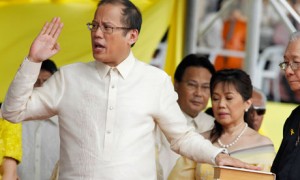Special to WorldTribune.com
By Donald Kirk, East-Asia-Intel.com
MANILA One long-running story forever dominates the front pages here. That’s corruption, bribery and cheating on a mass scale — so massive as to bear comparisons with that in big bully China.
The story now is that of a few senators sending special funds to an agency charged with conducting worthy projects. The projects didn’t exist, and the money went into the coffers of the senators.

That’s another variation on a familiar theme. The assumption is, even if the project is legit, the one who makes the deal gets 10 percent.
So does the person in charge of the agency or NGO, and so do underlings with hands extended for their percentage. Very little goes where it’s supposed to.
The story is so common that Hector Villaneuva, press secretary during the presidency of Fidel Ramos in the 1990s, looks upon the whole show with distinct disdain.
It’s “a quarrel among elite politicians,” he writes in the Manila Bulletin, “where the masses have no participation and are not direct beneficiaries of the greed, scams and criminal acts of politicians” and “executives” of President Benigno “Noynoy” Aquino III.
It was Noynoy’s mother, Corazon, who got elected president after Ramos led the charge to depose the thoroughly corrupt, dictatorial Ferdinand Marcos in the 1986 People Power Revolution.
Cory, of course, was the widow of Benigno Aquino Jr., the Marcos challenger gunned down at the airport, now named for him, in 1983 after alighting from a plane that had flown him from exile in the U.S.
It is tempting to compare corruption here with that in other countries where I’ve sojourned of late, South Korea and India, but the problem here is magnified many times.
South Korea’s chaebol chieftains get into trouble and out of trouble with amazing regularity, but the country has emerged with a remarkably functional system where the trains and buses run on time, utilities work, and few people live below the poverty line.
If the suicide rate in Korea is high and a lot of people aren’t happy, that’s testimony more to the intensely competitive nature of a hyper-driving society than to massive corruption and inefficiency.
What’s especially disturbing about the Philippines is that wildly improbable tales of theft by politicians and hide-and-seek with business people dominate the news.
They make for fun reading — but not to the exclusion of far more serious issues revolving around China’s enforcing its claim to the South China Sea.
People to whom I’ve talked assume that literally every politician, all members of the Philippine Congress, are rich on illicit wheeling and dealing.
It’s assumed the police accept payoffs for quashing charges on offenses large and small, while raking in gifts on a regular basis.
Against this background, stories of Chinese ships blocking access by Filipino boats to shoals in the South China Sea that the Philippines believes are Philippine territory are secondary.
As for a firefight between Philippine troops and the New People’s Army on the large southern island of Mindanao, so what if eight soldiers were killed while the rebels got away with a cache of weapons?
That incident was minor compared with the latest revelations of the illicit wealth of a senator and former defense minister, Juan Ponce Enrile, who aided Ramos in the overthrow of Marcos.
Like South Korea, though, the Philippines is a front-line state in the regional struggle for control over East Asia.
The Philippines and the U.S. are talking about a new agreement whereby several thousand U.S. troops would stay here all the time training the decrepit, graft-ridden armed forces to fight both the New People’s Army and resurgent Muslim terrorists.
Philippine activists are up in arms, figuratively, against expanding the U.S. presence in a country where the U.S. until about 1990 had its two biggest overseas bases, Clark Air Base north of Manila and Subic Bay to the west.
Like it or not, the Philippines represents the southern end of an arc of U.S. military power extending from South Korea, down through Okinawa, the southernmost Japanese prefecture, where people also are protesting its presence.
For several years a small U.S. contingent has been advising Philippine forces in the Sulu archipelago southwest of Mindanao under a “visiting forces” agreement that suggests they’re not “permanent.” U.S.-South Korea war games going on now in South Korea are a reminder of the potential for a flare-up that nobody wants.
It is difficult to say where the risk is higher — on the Korean peninsula, under the gun from the North, or in the South China Sea, increasingly under Chinese rule. And the scale of corruption in China renders that in the relatively free states nearby insignificant in comparison.
Considering the common denominator of China’s stake in both areas, and China’s claim to the Senkaku (Diaoyu) Islands held by Japan, the prospect of a regional war looms on the horizon.
Under these circumstances, you wonder where the fat-cat politicos would perceive their best interests. You suspect they would side with the winner, any winner, while shielding their ill-got fortunes from assaults from all sides.
Columnist Donald Kirk has written two books and innumerable articles on the Philippines’ problems. He’s at kirkdon@yahoo.com.

You must be logged in to post a comment Login